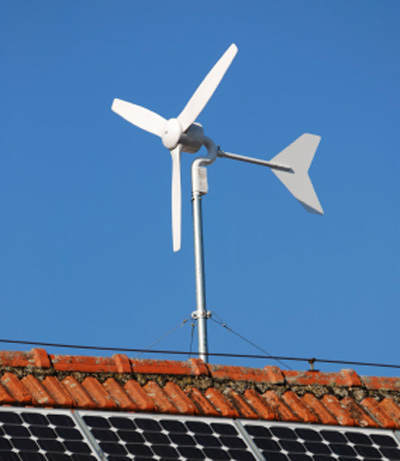Classifications and features of wind turbines
As we have explained in Things You Don't Know About Wind Turbines, a power generator is composed of two major parts: wind turbine, which converts wind power into mechanical energy, and generator, used to change mechanical energy into electricity. Based on different structures and techniques they adopt, and different mode they are integrated in, wind turbines can be classified into the following categories.Horizontal and vertical axis types
Concerning the main shaft direction of wind turbines, they can be classified into 2 types. Horizontal axis type, as the name indicates, has its rotating shaft parallel to the ground. Equipped with Yaw system, it can adjust its direction to face the wind. In contrast, vertical axis type has its rotating shaft perpendicular to the ground. This kind of wind turbine is simplified in design and easy in use, because it can work without facing the wind. Meanwhile, this design reduces the gyro force of wind turbines. With such advantages, vertical axis type has become a trend in the wind power industry.
Different blade numbers
In terms of the number of blades, wind turbine can be classified into single blade, double blades, triple blades and multiple blades types. The number of blades is determined by many factors including aerodynamic efficiency, complexity, cost, noise and aesthetics. Generally, large-scale wind turbines adopt double or triple blades. Wind turbine with less blades requires higher rotation speed to exploit the wind power, thereby making more noises. Meanwhile, too many blades will affect each other and reduce the working efficiency. Currently, 3 blade wind turbines dominate the market, partly because they look more stable and aesthetic.
Upwind and downwind types
According to the direction in which wind turbine accept the wind, there are upwind and down wind two types. Upwind type has its wind turbine in front of the wind tower, while downwind wind tower has its wind turbine at the back of it, and accepts wind with the back of the blades. Usually, upwind turbines adopt direction adjustment devices to keep the blades in the face of wind, while downwind turbines exempt the direction device because it can follow the wind automatically. But wind flow can blow back to the turbines in downwind types, thus cause disturbance and retard the efficiency. Given this reason, upwind type wind turbines are more widely used.
Synchronous and induction generators
In the light of different wind power generators, there exists synchronous generator and induction generator. Synchronous generators include permanent magnet synchronous generator, whose magnetic field is generated by permanent magnet; electrical excitation synchronous generator (EESG), whose magnetic field is generated by direct current from rotors. The currents outputted by stators were rectified and inverted to 50HZ AC, and then transmitted to the power grid.Induction generators also cover two types. Squirrel-cage inductor generator are widely use in mini and middle sized wind turbines due to its simple structure, low price and convenience in connecting to the power grid. Wound rotor doubly-fed induction generator can directly transmit power to the grid with the stator, while the rotor controlled by transducers can transmit active and reactive power to the grid.

High and low voltage types
In view of the output voltage, there are high voltage and low voltage wind turbines. High voltage type outputs range from 10 to 20 KW, even reach up to 40 KV, which can connect to the power grid directly without using voltage transformers. High voltage, direct drive and permanent magnetic pole structure make synchronous generator possible, which has become a promising wind turbine type. Low voltage type, on the other hand, is the most widely used wind turbine currently.Fixed and variable speed types
We can also refer to whether the rotation speed is constant and classify them into fixed speed and variable speed wind turbine generators. The former one is simplified in design, economical in construction, convenient in maintenance, and connected to power grid directly. But it is inferior in its low wind power efficiency, high load and interference with power grids. The later one features high aerodynamic efficiency, little power fluctuation, high cost efficiency and light support structures. But due to its high price and mass maintenance task, it is usually used in large capacity wind turbines.
Wind turbines of different rated powers
In addition, there are other ways to classify wind turbines. Based on the rated power, wind turbines can be divided into 4 grades. Micro-generator is rated at under 10KW, mini-generator is in the range of 10KW to 100KW, middle-generator 100KW to 1000KW, and large-generator over 1000KW.
The above are major classifications of wind turbines. Different wind turbines are adopted in diversified environments. With the growth of wind power industry, we are sure to witness a sharp increase in the wind turbine construction. TICO, one of China’s leading industrial crane supplier, has developed innovative wind turbine cranes for wind tower construction and maintenance. We are committed to provide high quality wind turbine cranes to meet your demands.
Get In touch Now!
Product

- single girder bridge crane
- double girder bridge crane
- gantry crane
- jib crane
- portable crane
- wind turbine crane
- Electric Hoist
Demark has built the world’s largest wind turbine
Demark has made the world’s largest wind turbine, with 88.4 meter-long wind blades. The powe...
Advantages and prospect of wind power
As a renewable energy, wind power is clean, economical, inexhaustible and flexible in use. Wit...
5 common wind turbine failures and maintenance
Here are 5 wind turbine maintenance methods for common wind turbine failures, including wind t...





